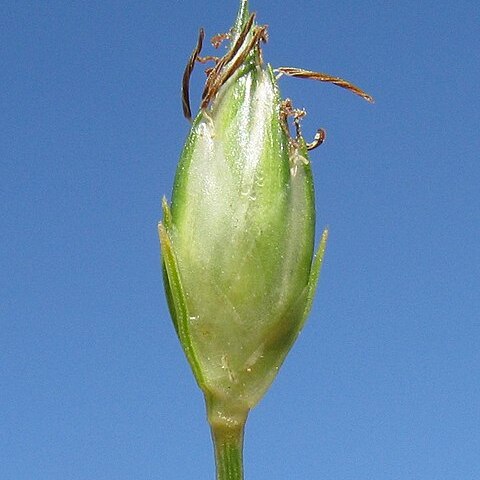Glabrous perennial with short rhizome. Stems densely tufted, compressed-trigonous, smooth, or scabrid at the top, somewhat incrassate at the base, (5-)15-40(-60) cm by ½-1 mm. Leaves basal, shorter than the stems, very narrow, rather abruptly acuminate, smooth, or slightly scabrid at the top, ⅔-1 mm wide; ligule absent. Inflorescence usually consisting of a single terminal spikelet, more rarely 1(-2) peduncled lateral spikelets added. Spikelets ovate or ovate-lanceolate, strongly compressed, ultimately often twisted, acute, shining stramineous or yellowish, 8-15(-30) by 4-6 mm; rachilla broadly winged. Glumes distichous, but at length often appear-ing subspiral by torsion of the rachilla, subcoriaceous, broadly ovate, acute, mucronate, with prominent 3-nerved keel and nerveless sides, 4½-5 by 4-4½ mm; lowest 1-2 empty glumes awned, the awn usually not exceeding the spikelet, or the lowest with a short, ½-1½ cm long blade. Stamens 2-3; anthers linear, 1½-3 mm long. Style triquetrous, pyramidally thickened at the base, hyaline-fimbriate almost to the base, 2-4 mm long; stigmas 3, much shorter than the style. Nut obtusely trigonous, pyriform, sessile, umbonate, coarsely tuberculate or almost muricate except for the smooth base, very rarely quite smooth (not in Malesia), stramineous to greyish brown, 2-3 by 1¼-2mm; epidermal cells minute, isodiametric.
More
Perennials. Rhizomes short. Culms tufted, 15-35 cm tall, slender. Leaves 1/2-2/3 as long as culm; leaf blade 0.5-1 mm wide, apex acute. Involucral bracts 1-3, glumelike but basalmost sometimes leaflike, 0.5-1.8 cm, apex with a 2-3 mm awn. Inflorescences reduced to a single terminal spikelet, ovoid, ellipsoid, or oblong-ovoid, 7-13 × ca. 5 mm, slightly compressed, with basal glumes distichous and apical ones spirally imbricate. Glumes yellowish green, broadly ovate to ovate, 3-6 mm, leathery, shiny, abaxially 3-veined, midvein prominent and excurrent into a mucro. Stamens 3. Style 3-sided, basally inflated; stigmas 3. Nutlet shortly stipitate, obovoid, ca. 2 mm, 3-sided, prominently verruculose. Fl. and fr. Jun-Sep. 2n = 10.
Slender tufted rhizomatous perennial with crowded culms swollen at the base
Solitary pale green or yellowish-buff spikelets 1 cm. long
Filiform or narrowly linear leaves
Sunny or partly shaded grasslands, sandy heaths, roadsides, teak-forests, at low altitudes, 0-900 m, rarely (in W. Java on Mt Gedeh and in New Guinea) collected at 1200 m.
More
Dry or wet open grassland, open forests, coastal rock outcrops. Sunny or partly shaded grasslands, sandy heaths, roadsides, teak-forests, at elevations up to 900 metres.
In grassland and savanna.


